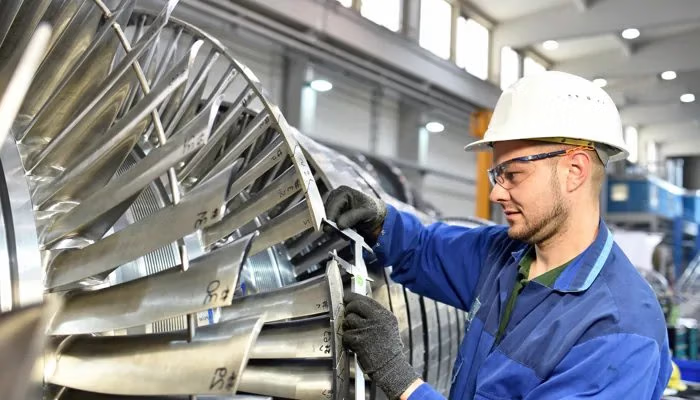Summary: In fast-paced manufacturing, minimizing downtime is vital. Every outage minute can cause substantial losses in productivity, revenue, and customer trust. That’s why MTTR (Mean Time to Repair) is one of the most important key performance indicators for maintenance teams. MTTR tracks the average time needed to acknowledge an incident, diagnose the issue, make the repair, and return systems or components to full operation. A high MTTR means longer unplanned downtime, reduced efficiency, and higher costs. A low MTTR keeps production moving and protects profitability.
This guide breaks down how to calculate MTTR, strategies to lower it, and how smart digital tools can make all the difference.
What is Mean Time to Repair (MTTR)?
MTTR is a metric used to track and manage maintenance and operational performance. It includes the time it takes to detect and respond to incidents and the time required to recover from them. A high Mean Time to Repair indicates longer resolution times and suggests potential issues with maintenance processes, equipment reliability, or response strategies.
Understanding MTTR
MTTR, or Mean Time to Repair, is a maintenance metric used to measure the average amount of time required to repair a system or component after a failure occurs. It encompasses the time from when the failure is first detected or reported until the system or component is fully operational again. MTTR is often used interchangeably with Mean Time to Recovery or Mean Time to Restore, as they all capture the same concept of repair time.
The Role of MTTR in Incident Management
In incident management, MTTR plays a vital role in assessing the efficiency and effectiveness of the response to system failures or incidents. It provides valuable insights into the stability of a DevOps team and the overall reliability of a product or system. By tracking it, organizations can identify bottlenecks, optimize repair processes, and ensure timely resolution of issues to minimize downtime.
To optimize Mean Time to Repair, manufacturers can implement proactive maintenance strategies, improve response times through streamlined processes, invest in better diagnostic tools, and enhance overall system maintainability. By reducing it, companies can mitigate the impact of downtime, improve operational uptime, and ultimately enhance customer satisfaction through reliable service delivery.
Calculating MTTR
The MTTR Formula and Its Components
To calculate it, you need to consider the total time it takes to repair a system or component and divide it by the total number of repairs within a given period. The formula is as follows: MTTR = Total Repair Time / Number of Repairs
The total repair time includes the time required to acknowledge, diagnose, troubleshoot, fix, and validate the restoration of the system or component. By measuring this metric consistently, organizations can track their performance over time and identify areas for improvement.
Incident Metrics and MTTR
MTTR is just one of the incident metrics used to measure the average time it takes to resolve an incident. Other related metrics include Mean Time to Resolution (MTTRs), Mean Time to Respond (MTTRsp), and Mean Time to Resolve (MTTRsv). These metrics provide a comprehensive view of incident management performance, highlighting the time it takes to acknowledge the issue, respond to it, and ultimately resolve it.
What helps minimize downtime?
Maintenance management software enhances response and recovery.
The Significance of MTTR in Manufacturing
Enhancing Reliability: The Link between MTTR and MTBF
MTTR and Mean Time Between Failures (MTBF) are two metrics that go hand in hand in assessing the reliability of manufacturing systems. While MTTR measures the time it takes to repair a system after a failure, MTBF measures the average time between failures. By reducing MTTR and increasing MTBF, organizations can achieve higher reliability and minimize disruptions in their production line.
MTTR as a Key Performance Indicator (KPI)
MTTR is a key performance indicator for manufacturing companies, reflecting their ability to quickly and effectively recover from system failures. A low MTTR indicates efficient incident response, streamlined repair processes, and a proactive approach to maintaining the stability of production systems. By actively monitoring and reducing MTTR, organizations can improve their overall operational efficiency and drive continuous improvement.
Reducing MTTR: Strategies for Efficiency
Incident Response: Acknowledge, Resolve, Recover
Effective incident response is crucial in minimizing MTTR. It involves a structured approach that includes acknowledging the incident, promptly resolving the issue, and ensuring a smooth recovery process. Organizations can outline clear roles and responsibilities by establishing an incident response plan, defining escalation procedures, and leveraging automation tools to expedite incident resolution.
The Power of DevOps
DevOps, a collaborative approach that combines development and operations teams, plays a significant role in reducing MTTR. DevOps teams can quickly identify and address issues by fostering collaboration and cross-functional communication, ensuring faster resolution and recovery. Additionally, leveraging automation, continuous integration, and deployment practices can streamline the release and maintenance of systems, further reducing Mean Time to Repair.
The Benefits of Low MTTR
1. Increased Productivity and Minimized Downtime
Reducing MTTR leads to increased productivity and minimized downtime in manufacturing operations. With faster incident resolution, production systems experience shorter periods of disruption, allowing for uninterrupted workflow and higher output. This leads to improved operational efficiency, optimized resource utilization, and higher profitability.
2. Enhanced Customer Satisfaction and Business Reputation
Low MTTR directly impacts customer satisfaction and business reputation. Customers value reliable products and services, and quick issue resolution contributes to a positive customer experience. Organizations build trust, loyalty, and a strong brand reputation by minimizing downtime and promptly addressing failures.
Measuring MTTR Effectively
Tracking MTTR
Organizations can leverage incident management tools and techniques to measure MTTR effectively. These tools automate the tracking and reporting of incidents, providing real-time visibility into repair times and performance trends. By analyzing Mean Time to Repair data over time, organizations can identify areas of improvement, allocate resources strategically, and set realistic targets for reducing repair times.
Exploring Availability and Reliability Metrics
While MTTR is a critical metric, it is essential to consider other metrics that provide a holistic view of system performance. Availability and reliability metrics, such as uptime percentage, Mean time to failure (MTTF), and Mean time between failures (MTBF), complement Mean Time to Repair by assessing the overall stability and resilience of manufacturing systems. By monitoring these metrics collectively, organizations can gain deeper insights into their operational effectiveness.
Common Challenges and Solutions
Uncovering the Source of Issues
One common challenge in reducing MTTR is identifying the root causes of failures. Root cause analysis techniques like the 5 Whys and Fishbone diagrams can help organizations dig deeper into incidents and identify underlying issues. By addressing root causes, organizations can implement preventive measures, proactively eliminate recurring problems, and further reduce Mean Time to Repair.
Maintenance and Repair Processes
Streamlining maintenance and repair processes is crucial for reducing MTTR. Organizations should establish standardized procedures, leverage automation tools, and provide comprehensive training to their maintenance teams. By optimizing workflows and minimizing manual interventions, organizations can accelerate repair times, improve efficiency, and achieve lower Mean Time to Repair.
The Future of MTTR
Emerging Technologies and Their Impact on MTTR
As technology advances, new tools and methodologies are emerging that can further optimize MTTR. Predictive maintenance, machine learning algorithms, and artificial intelligence (AI) can enable proactive identification of potential failures and recommend optimal repair strategies. By harnessing these technologies, organizations can anticipate and address issues before they escalate, resulting in reduced Mean Time to Repair and enhanced operational resilience. Manufacturing maintenance software integrates these technologies to reduce MTTR and enhance operational resilience.
Sustaining Low MTTR in the Long Run
Sustaining low MTTR requires a culture of continuous improvement. Organizations should foster a mindset of learning from incidents, promoting knowledge sharing, and implementing feedback loops. By regularly reviewing incident data, conducting post-incident reviews, and implementing corrective actions. The organizations can continually refine their incident response processes and maintain low Mean Time to Repair levels.
Conclusion
MTTR plays a pivotal role in the manufacturing industry, ensuring that production systems recover quickly from failures and minimize downtime. By measuring and optimizing MTTR, organizations can enhance operational efficiency, reduce costs, and improve customer satisfaction. By reducing Mean Time to Repair and continuously improving incident response processes, manufacturing companies can optimize their production line, minimize disruptions, and achieve higher operational excellence.
FAQ | MTTR
What is the significance of MTTR in manufacturing?
It is crucial in manufacturing as it measures the average time it takes to repair a system or component after a failure. It helps assess the efficiency of incident response, minimize downtime, and improve operational productivity.
How is MTTR calculated?
It is calculated by dividing the total repair time by the number of repairs. The formula is: MTTR = Total Repair Time / Number of Repairs.
How can organizations measure MTTR effectively?
Organizations can effectively measure it using incident management tools that automate incident tracking and reporting. Other metrics, like availability and reliability, should also be considered to view system performance comprehensively.
How does MTTR relate to other maintenance metrics?
MTTR (Mean Time to Repair) measures the average time required to restore a system after failure. It is often considered alongside MTBF (Mean Time Between Failures), MTTF (Mean Time to Failure), and MDT (Mean Downtime) to assess overall equipment reliability and maintenance efficiency.
What role does predictive maintenance play in reducing MTTR?
Predictive maintenance uses data analysis and machine learning to anticipate failures before they occur, allowing for scheduled repairs that reduce MTTR by minimizing unexpected downtime.
What is the relationship between MTTR and Total Productive Maintenance (TPM)?
TPM focuses on maximizing equipment effectiveness, and reducing MTTR is a critical component of TPM strategies to ensure minimal downtime and maximum productivity.
Can MTTR be used to evaluate the performance of third-party maintenance services?
Yes, it is often used as a key performance indicator in service-level agreements (SLAs) to assess the efficiency and responsiveness of third-party maintenance providers.
How does MTTR influence the decision to repair versus replace equipment?
A high MTTR may indicate that equipment is nearing the end of its useful life, prompting a cost-benefit analysis to determine whether replacement is more economical than continued repairs.
What is the future of MTTR in manufacturing?
The future of MTTR in manufacturing involves leveraging emerging technologies such as predictive maintenance, machine learning, and AI to identify and address issues before they escalate proactively. Continuous improvement and learning from incidents will also play a key role.
Image: Adobe Stock – Copyright: © industrieblick – stock.adobe.com





